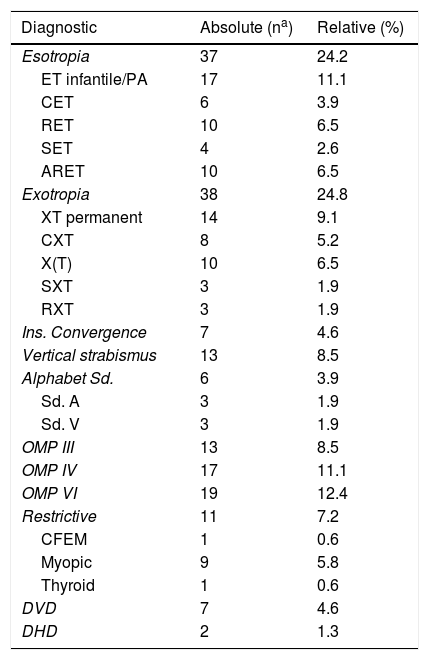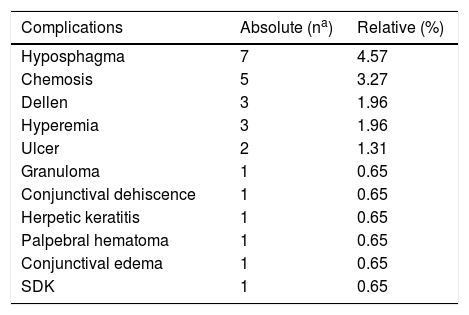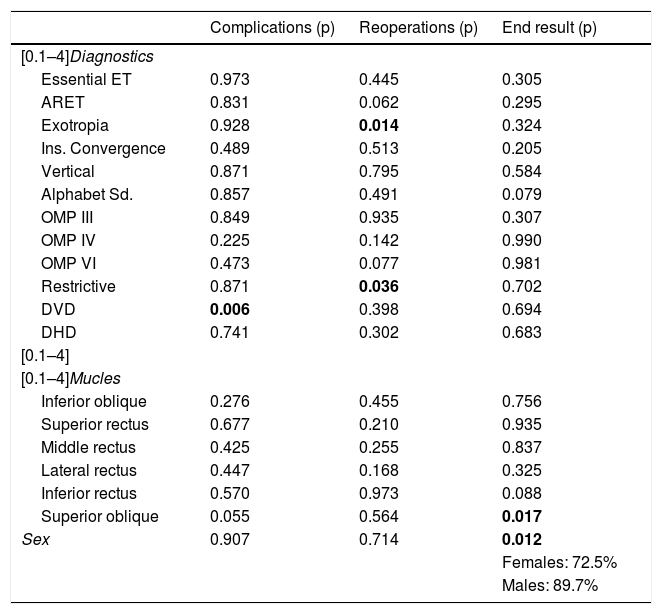to analyze the strabismus surgeries and the outcomes during a year and a half in a tertiary hospital.
Material and methodsa retrospective study of patients who underwent strabismus surgery. The mean age, sex, diagnosis, diplopia, surgery, anesthesia, adjustable sutures, results, reoperations and follow-time from surgery were analyzed. A good outcome was considered when the final horizontal deviation was less than 10 prism diopters (pd) and the vertical deviation, less than 5 pd without diplopia.
Resultsa total of 153 cases were operated on, mean age: 43.14±25.58 years (61.4%: women). The 74.5% was ≥18 years (33.33%≥ 60). The 51% had diplopia. The most frequent deviation was horizontal: 83.6%. The most frequent diagnosis was cranial nerve palsies: 32% (VI nerve: 12.4%), restrictive strabismus: 7.2%, and the aged related distance esotropia: 6.5%. Adjustable sutures were used in the 19.7% and topical anesthesia in 65.4%. The 79.2% had good outcomes at the end of follow-up. Reoperations were needed in 25.5%. Follow-up evolution time was 11.87 months ± 6.5. The sex female (P=0.012) and the oblique superior surgery (P=0.017) were associated to a bad result.
Conclusionthe adult strabismus surgery was three times more frequent than the children strabismus surgery; the third of the adults that were operated on were ≥ 60 years. The cranial nerve palsies were the most frequent diagnosis. Adjustable sutures were rarely used. The good outcomes were obtained in most of the patients at the end of follow-up.
Analizar las cirugías de estrabismo y los resultados durante un año y medio en un hospital terciario.
Material y MétodosEstudio retrospectivo de pacientes operados de estrabismo. Se analizó la edad media, sexo, diagnóstico, diplopía, técnica y anestesia, suturas ajustables, resultados, re-intervenciones y tiempo de seguimiento desde la cirugía. Se consideró buen resultado una desviación horizontal < 10 dioptrías prismáticas (dp) y vertical < 5 dp, sin diplopía.
ResultadosSe operaron 153 casos de edad media 43,14±25,58 años 61,4% mujeres. El 74,5% era≥de 18 años 33,33% ≥ de 60). El 51% tenía diplopía. La desviación más frecuente fue horizontal: 83,6%. El diagnóstico más frecuente fue la parálisis de los nervios craneales: 32% VI nervio: 12,4%, los estrabismos restrictivos representaron un 7,2% y la esotropía asociada a la edad un 6,5%. Se emplearon suturas ajustables en un 19,7% y anestesia tópica en un 65,4%. Un 79,2% obtuvo buenos resultados al final del seguimiento. Las re-intervenciones fueron el 25,5%. El tiempo medio de seguimiento: 11,87 meses ± 6,5. El sexo femenino P=0,012, y la cirugía de oblicuo superior P=0,017 se asociaron a un peor resultado.
ConclusiónLa cirugía del estrabismo del adulto fue tres veces más frecuente que la de los niños, la tercera parte de los adultos que se operaron eran≥de 60 años. Las parálisis fueron la patología más frecuente. Las suturas ajustables se emplearon en escaso número de pacientes Se obtuvieron buenos resultados en la mayoría de los casos.
Artículo
Comprando el artículo el PDF del mismo podrá ser descargado
Precio 19,34 €
Comprar ahora










